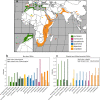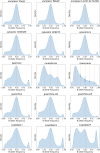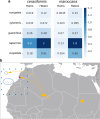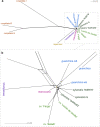Phylogenomics of the Olea europaea complex using 15 whole genomes supports recurrent genetic admixture together with differentiation into seven subspecies
- PMID: 37069619
- PMCID: PMC10111821
- DOI: 10.1186/s12915-023-01583-5
Phylogenomics of the Olea europaea complex using 15 whole genomes supports recurrent genetic admixture together with differentiation into seven subspecies
Abstract
Background: The last taxonomic account of Olea recognises six subspecies within Olea europaea L., including the Mediterranean olive tree (subsp. europaea) and five other subspecies (laperrinei, guanchica, maroccana, cerasiformis, and cuspidata) distributed across the Old World, including Macaronesian islands. The evolutionary history of this monophyletic group (O. europaea complex) has revealed a reticulated scenario involving hybridization and polyploidization events, leading to the presence of a polyploid series associated with the subspecies. However, how the polyploids originated, and how the different subspecies contributed to the domestication of the cultivated olive are questions still debated. Tracing the recent evolution and genetic diversification of the species is key for the management and preservation of its genetic resources. To study the recent history of the O. europaea complex, we compared newly sequenced and available genomes for 27 individuals representing the six subspecies.
Results: Our results show discordance between current subspecies distributions and phylogenomic patterns, which support intricate biogeographic patterns. The subspecies guanchica, restricted to the Canary Islands, is closely related to subsp. europaea, and shows a high genetic diversity. The subsp. laperrinei, restricted now to high mountains of the Sahara desert, and the Canarian subsp. guanchica contributed to the formation of the allotetraploid subsp. cerasiformis (Madeira islands) and the allohexaploid subsp. maroccana (western Sahara region). Our phylogenomic data support the recognition of one more taxon (subsp. ferruginea) for the Asian populations, which is clearly segregated from the African subsp. cuspidata.
Conclusions: In sum, the O. europaea complex underwent several processes of hybridization, polyploidy, and geographical isolation resulting in seven independent lineages with certain morphological traits recognised into subspecies.
Keywords: Macaronesian islands; Olive (Olea europaea); Phylogenomics; Polyploidy; Subspecies.
© 2023. The Author(s).
Conflict of interest statement
The authors declare that they have no competing interests.
Figures





Similar articles
-
Polyploidy in the olive complex (Olea europaea): evidence from flow cytometry and nuclear microsatellite analyses.Ann Bot. 2008 Jan;101(1):25-30. doi: 10.1093/aob/mcm275. Epub 2007 Nov 15. Ann Bot. 2008. PMID: 18024415 Free PMC article.
-
Genomic evidence for recurrent genetic admixture during the domestication of Mediterranean olive trees (Olea europaea L.).BMC Biol. 2020 Oct 26;18(1):148. doi: 10.1186/s12915-020-00881-6. BMC Biol. 2020. PMID: 33100219 Free PMC article.
-
Genetic diversity and differentiation processes in the ploidy series of Olea europaea L.: a multiscale approach from subspecies to insular populations.Mol Ecol. 2009 Feb;18(3):454-67. doi: 10.1111/j.1365-294X.2008.04027.x. Epub 2008 Dec 16. Mol Ecol. 2009. PMID: 19143937
-
Molecular studies in olive (Olea europaea L.): overview on DNA markers applications and recent advances in genome analysis.Plant Cell Rep. 2011 Apr;30(4):449-62. doi: 10.1007/s00299-010-0991-9. Epub 2011 Jan 7. Plant Cell Rep. 2011. PMID: 21212959 Review.
-
Current Status of Biodiversity Assessment and Conservation of Wild Olive (Olea europaea L. subsp. europaea var. sylvestris).Plants (Basel). 2022 Feb 10;11(4):480. doi: 10.3390/plants11040480. Plants (Basel). 2022. PMID: 35214813 Free PMC article. Review.
Cited by
-
Revisiting the History and Biogeography of Bactrocera oleae and Other Olive-Feeding Fruit Flies in Africa and Asia.Insects. 2024 Dec 31;16(1):30. doi: 10.3390/insects16010030. Insects. 2024. PMID: 39859611 Free PMC article.
-
Genealogical tracing of Olea europaea species and pedigree relationships of var. europaea using chloroplast and nuclear markers.BMC Plant Biol. 2023 Sep 26;23(1):452. doi: 10.1186/s12870-023-04440-3. BMC Plant Biol. 2023. PMID: 37749509 Free PMC article.
-
Wild and cultivated olive tree genetic diversity in Greece: a diverse resource in danger of erosion.Front Genet. 2023 Dec 4;14:1298565. doi: 10.3389/fgene.2023.1298565. eCollection 2023. Front Genet. 2023. PMID: 38111682 Free PMC article.
-
Transcriptome analysis of historic olives reveals stress-specific biomarkers.Front Plant Sci. 2025 Jun 5;16:1549305. doi: 10.3389/fpls.2025.1549305. eCollection 2025. Front Plant Sci. 2025. PMID: 40538876 Free PMC article.
References
-
- Green PS, Wickens GE. The Olea europaea complex. Edinburgh: The Davis & Hedge Festschrift, Edinburg University Press; 1989.
-
- Green PS. A revision of Olea L. (Oleaceae) Kew Bull. 2002;57:91. doi: 10.2307/4110824. - DOI
-
- Vargas P, Muñoz Garmendia F, Hess J, Kadereit J. Olea europaea subsp. guanchica and subsp. maroccana (Oleaceae), two new names for olive tree relatives. Anales del Jardín Botánico de Madrid. 2000;58:360–1.
Publication types
MeSH terms
LinkOut - more resources
Full Text Sources

